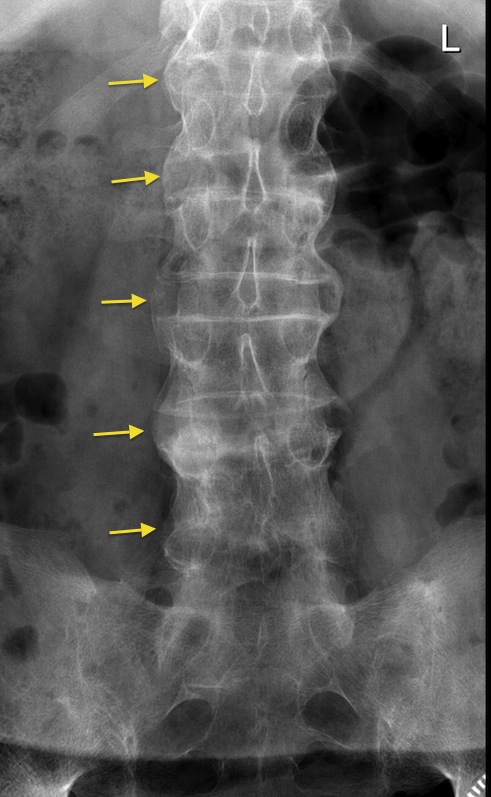


The index of suspicion for patients who cannot give complete histories should be high with imaging investigations to rule out unreported injury.We would like to remind clinicians of the special care needed when assessing patients with ankylosing spondylitis and identify the following important points It is this stiffness that is predominantly responsible for fracture, as whilst the rate of spinal fractures is increased in patients with ankylosing spondylitis, the rate of limb fractures is not. Inflammation and osteo-proliferation contribute to the characteristic features of ankylosing spondylitis namely stiffness and lack of spinal mobility. Delays to diagnosis (of vertebral fracture) and secondary neurological injury have unfortunately been reported historically and continue to occur, such as in the presented case. It is noted that patients with spinal ankylosing disorders are particularly susceptible to injury with only minimal trauma, and injuries are not always noticed expediently.

#Bamboo spine full#
Unfortunately, his neurology has not recovered, and he requires full nursing care. He was transferred to a regional spinal specialist Centre, and after discussion with his next of kin, underwent thoracolumbar instrumentation to prevent deterioration of neurological function. Radiographs of the lumbar spine showed a bamboo spine appearance a late sign in keeping with ankylosing spondylitis ( Figure 1) and pelvic radiography revealed no abnormality.įigure 2: Sagittal MRI showing unstable fracture at thoracolumbar junction (white arrows illustrate anterior and posterior elements of fracture). Examination of his hip joints shown no deformity, tenderness, swelling or bruising and there was full passive movement of hips, knees and ankles. The history was said to be challenging to obtain, and the patient complained of bilateral hip pain. The reason for ED attendance was reluctance to mobilize. Observations in ED were: heart rate 89 bpm, respiratory rate 18 bpm, blood pressure 136/83, Temp-37☌. He had a past medical history of profound learning disability, cerebral palsy, epilepsy and ankylosing spondylitis, and was usually independently mobile indoors. Case DescriptionĪ 60-year-old gentleman was assessed in a District General (non-specialist) Hospital Emergency Department (ED) three days after an unwitnessed fall from standing in his care home. The aim of our case study is to remind clinicians that patients with ankylosing spinal conditions may suffer significant injury from innocuous sounding mechanisms. We are of the opinion that diligence should be exercised when assessing this patient group and feel the presented case highlights the importance of enough radiological assessment. We present a case of missed spinal injury in someone with ankylosing spondylitis that led to severe consequences for the patient. The radiological appearance of bamboo spine should sharpen the clinical judgement of all who encounter it.Ĭhance Ossified discs Paraplegia Thoracolumbar instrumentation Missed injury Introduction We would like to highlight the importance of maintaining a high index of suspicion for patients who cannot give complete histories. The absence of a fracture on radiographs in patients that have ankylosing spondylitis does not eliminate the presence of a fracture, and CT and MRI may well be indicated to confirm that there is no bony injury. The mechanism of injury in this case was a fall from standing height which ultimately resulted in a severe spinal fracture with paraplegia. Bamboo spine occurs when the intervertebral discs ossify this decreases flexibility and significantly increases the likelihood of spinal fracture with low energy mechanisms of injury. We present a radiograph showing a classic appearance of “bamboo spine”, and subsequent MRI showing a three-column fracture. We present a case of missed spinal injury in a patient with ankylosing spondylitis that led to severe consequences for the patient.


 0 kommentar(er)
0 kommentar(er)
